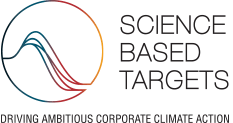In November 2021, Hulic formulated greenhouse gas emissions reduction targets in order to contribute to promote carbon-free society in accordance with the Paris Agreement.
| 2030 | 2050 | |
|---|---|---|
| Scope1 and 2*1 | Reduce by 70% | Sustaintially zero |
| Scope3*2 | Reduce by 30% | Sustaintially zero |
- *1Emissions from energy consumptions by the reporting company.
Scope1: emissions from operations that are owned or controlled by the reporting company.
Scope2: emissions from the generation of purchased or acquired electricity, steam, heating, or cooling consumed by the reporting company. - *2All indirect emissions (not included in scope2) that occur in the value chain of the reporting company, including both upstream and downstream emissions.
Target was set for Categories 11 and 13, which covered approximately 80% of Scope3.
Hulic has had its near-term (by 2030) emissions reduction targets approved by the Science Based Target initiative*3 (SBTi) as consistent with levels required to meet the goals of the Paris Agreement in 2022. The targets covering greenhouse gas emissions from the Company’s operations (Scope1 and 2) are consistent with reductions required to keep the global warming to 1.5℃, the most ambitious goal of the Paris Agreement. In addition, the Company’s target for the emissions from its value chain (Scope3) meets the SBTi’s criteria for ambitious value chain goals, meaning they are in line with current best practice.

- *3Science Based Targets initiative (SBTi)
A collaboration between CDP, the United Nations Global Compact, World Resources Institute (WRI) and the World Wide Fund for Nature (WWF), and is an international initiative that promote private sector to develop GHG emissions reduction targets in line with Paris Agreement (long-term temperature goal is to keep the rise in mean global temperature to well below 2℃ and limiting below 1.5℃ above pre-industrial levels), then validate and approve targets submitted to them. For approval, GHG emissions need to comply with GHG Protocol accounting and reporting standards, and near-term reduction targets in line with Paris Agreement need to be set between 5 and 15 years from the date of target submission to SBTi.
Hulic’s Actions for Achieving the Targets
We agree with the Japan government’s 2050 carbon neutrality target and are promoting the following initiatives to achieve the greenhouse gas emissions reduction target.
GHG Emissions Reduction Progress
| Base Year (2019) Result |
2024 Result | ||
|---|---|---|---|
| Emission (t-CO2e) |
Emission (t-CO2e) |
Change from base year (2019) |
|
| Scope1+2 | 39,997 | 14,017 | (65)% |
| Scope3 (Categories 11&13) |
180,209 | 144,443 | (20)% |
- Scope2 reduction: Replace 100% of the electricity required for business activities of Hulic Group with renewable energy and achieved RE100*4 in 2023 and continuously achieved in 2024.
- Scope2 and Scope3 reductions: By 2029, we will invest a total of approximately 66 billion yen in the development of renewable energy power plants. These will generate approximately 330 GWh electricity, equivalent to the annual electricity consumption of all of our buildings*5, and supplying renewable electricity to our buildings. In addition to solar power plants, we have developed small hydroelectric power plants to ensure the resilience of renewable energy sources*6. Additionally, approximately 100 billion yen will be invested in grid-scale storage battery by 2034 to ensure stable supply of renewable energy.
- Other: Implementing value chain (Scope3) engagements:
- ✓Upstream activities of the supply chain
- Using environmentally friendly construction materials
- Promoting timber construction and use of wood materials
- Using renewable energy at construction sites
- Incorporating environmental considerations into internal standards, etc.
- ✓Downstream activities of the supply chain
- Switching building electricity to renewable energy
- Introducing environmentally friendly technologies in buildings
- Energy-efficient design/renovation
- Reducing energy consumption in collaboration with customers (concluding of green lease agreements*7・introducing of green lease clauses)
- ✓To achieve the goals of 30% reduction in GHG emissions by 2030 (SBT Certification Targets) and virtually zero GHG emissions by 2050, we aim to achieve these goals through measures such as reduction of GHG emissions during building operation through active adoption of new technologies and materials, and long-term results expected from investments in venture companies and joint research with the academic world in addition to 100% renewable energy for electricity used at all company-owned buildings.
- ✓Upstream activities of the supply chain
- *4RE100 (Renewable Electricity 100%)
An international initiative in which member companies aim to use 100% renewable sources for the energy required for their business activities. - *5All Company-owned properties
Excludes single-tenant lease properties, residential properties and unmanaged shared properties for which the Company does not manage energy, and real estate for sale, etc. - *6Secure resilience of renewable energy sources
Supply electricity stably by using multiple energy sources. - *7Green lease agreements
Building owners and tenants collaborate to reach voluntary agreements with regards to energy saving and mitigating other environmental burdens of real estate as well as improvements of indoor environments through contracts, etc., and implement actions agreed.
